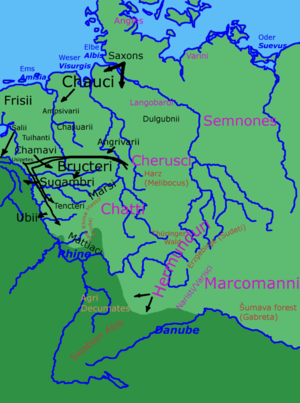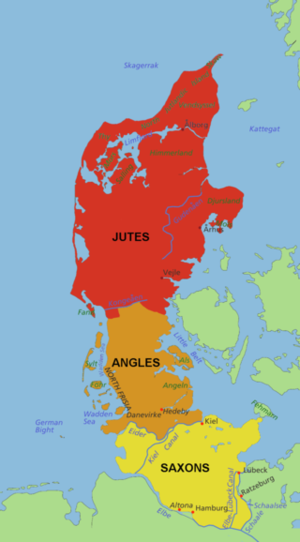Anglia

Anglia (German and Low Saxon: Angeln, Danish: Angel) is a small peninsula within the larger Jutland (Cimbric) Peninsula in the region of Southern Schleswig, which constitutes the Northern part of the northernmost German federal state of Schleswig-Holstein, protruding into the Bay of Kiel of the Baltic Sea.
Contents
Location
To the south, Anglia is separated from the neighbouring peninsula of Schwansen (Danish: Svans or Svansø) by the Schlei (Slien) inlet, and to the north from the Danish peninsula of Sundeved (German: Sundewitt) and the Danish island of Als (Alsen) by the Flensburg Firth (Flensburger Förde, Flensborg Fjord). The landscape is hilly, dotted with numerous lakes. Whether ancient Anglia conformed to the borders of the Anglian Peninsula is uncertain. It may have been somewhat larger; however, the ancient sources mainly concur that it also included the peninsula's territory.
Terminology
The German word Angeln has been hypothesised to originate from the Germanic Proto-Indo-European root *h₂enǵʰ-, meaning "narrow" (compare German and Dutch eng = "narrow"), meaning here "the Narrow [Water]", i.e. the Schlei estuary; the root would be angh, "tight". Another theory is that the name meant "hook", as in angling for fish; linguist Julius Pokorny derived it from the Proto-Indo-European root *ang-, "bend" (see ankle).[1] It is also possible that the Angles may have been called such because they were a fishing people or were originally descended from such [2].
Geography
Together with Schwansen (Danish: Svans), Danish Wahld (German: Dänischer Wohld, Danish: Jernved) and Wagria (Wagrien, Vagrien), Anglia is one of four peninsulas along the Baltic Sea coast of the northernmost German federal state of Schleswig-Holstein. As part of the Schleswig-Holstein Morainic Uplands (Schleswig-Holsteinisches (Moränen-) Hügelland), that were formed during the Weichselian glaciation, these peninsulas are hilly and dotted with several glacial lakes. The Anglian glacial lakes form the North Anglian Lake Group (Nordangeliter Seengruppe). The River Treene (Danish: Trenen) with its main headstream Bondenau (Bondeåen) rises in Anglia. Although rising on the Anglian Peninsula in the Baltic Sea, the Treene flows towards the North Sea, being the main tributary of the River Eider (Ejderen), the river that constituted the Southern border of the Danish Realm for a very long time.
Apart from Flensburg, which is an independent town, the Anglian Peninsula belongs to the district of Schleswig-Flensburg (Danish: Slesvig-Flensborg), Germany's northeasternmost district (seat: Schleswig). The district has approximately 197,000 inhabitants.
Mention by Panini
Anguliya (अंगुलीय) is a term mentioned by Panini in Ashtadhyayi. [3]
History
Anglia has a significance far beyond its current small area and country terrain, in that it is believed to have been the original home of the Angles, Germanic immigrants to East Anglia, Central and Northern England, and the Eastern Scottish Lowlands. This migration led to their new homeland being named after them, from which the name "England" derives. Both England and the English language, thus, ultimately derive at least their names from Anglia.
The region was home to the Germanic people, the Angles, some of whom, together with Saxons and Jutes, left their home to migrate to Britain in the 5th and 6th centuries. For the years 449-455, the Anglo-Saxon Chronicle, written around 890, describes how King Vortigern (a British tribal king) invited the Angles to come and receive land in return for helping him defend against marauding Picts. Those successful Angles sent word back that good land was available and that the British were 'worthless'. (In fact, the racial contempt of the Angles towards the Britons was an invention of the monk Gildas, who is part founder of this origin myth. His object was to vilify the decadence of the British leadership). A wholesale emigration of Angles and kindred German peoples followed.
The Chronicle, commissioned by King Alfred the Great, drew on earlier oral traditions and on the few written fragments available. The best of these, written around 730, was by the monk Bede whose history of English Christianity had the following brief account of the origin and distribution of the Angles:[4]
- from the Angles, that is, the country which is called Anglia, and which is said, from that time, to remain desert to this day, between the provinces of the Jutes and the Saxons, are descended the East Angles, the Midland Angles, Mercians, all the race of the Northumbrians, that is, of those nations that dwell on the north side of the River Humber, and the other nations of the English.
.....— Bede's Ecclesiastical History of the English People, Book I, Chapter XV, 731 A.D.
The phrase "north of the Humber" refers to the northern kingdom of Northumbria, which includes what is now north and north-eastern England and part of southern Scotland. Mercia was located in central England and broadly corresponds to what is now known as the English Midlands.
This account can be related to the evidence of archaeology, notably the distribution of types of fibulae, or brooches, worn by the women. In essence, there are two kinds at issue, the saucer brooch and the cruciform brooch. East coastal and northern Britain were settled by women wearing cruciform brooches, which were in use in coastal Scandinavia, all of Denmark, and Schleswig-Holstein all the way south to the lower Elbe and all the way east to the Oder, as well as a pocket in coastal Friesland.
Later history:
After the Angles departed from Anglia, by the 8th century the region was occupied by Danes. This is reflected in the large number of place names ending in -by (meaning -village) in the region today. In the 10th century, the chronicler Æthelweard reports that the most important town in Anglia was Hedeby.
Later Anglia's history is subsumed in that of the larger surrounding region, which came to be known as Southern Jutland or Schleswig (Danish: Slesvig). Until the 19th century, the area belonged primarily to Denmark. But, in terms of ethnic and linguistic heritage, a mixed German/Danish population evolved. Denmark lost Schleswig to Austria and Prussia in 1864 as a result of the Second Schleswig War. In 1920, following Germany's defeat in the First World War, a plebiscite was held to determine which areas should return to Danish control. As a result of the plebiscite, much of Schleswig returned to Denmark, but Anglia remained in Germany.
प्राचीनकाल में यूरोप देश
दलीप सिंह अहलावत[5] लिखते हैं: यूरोप देश - इस देश को प्राचीनकाल में कारुपथ तथा अङ्गदियापुरी कहते थे, जिसको श्रीमान् महाराज रामचन्द्र जी के आज्ञानुसार लक्ष्मण जी ने एक वर्ष यूरोप में रहकर अपने ज्येष्ठ पुत्र अंगद के लिए आबाद किया था जो कि द्वापर में हरिवर्ष तथा अंगदेश और अब हंगरी आदि नामों से प्रसिद्ध है। अंगदियापुरी के दक्षिणी भाग में रूम सागर और अटलांटिक सागर के किनारे-किनारे अफ्रीका निवासी हब्शी आदि राक्षस जातियों के आक्रमण रोकने के लिए लक्ष्मण जी ने वीर सैनिकों की छावनियां आवर्त्त कीं। जिसको अब ऑस्ट्रिया कहते हैं। उत्तरी भाग में ब्रह्मपुरी बसाई जिसको अब जर्मनी कहते हैं। दोनों भागों के मध्य लक्ष्मण जी ने अपना हैडक्वार्टर बनाया जिसको अब लक्षमबर्ग कहते हैं। उसी के पास श्री रामचन्द्र जी के खानदानी नाम नारायण से नारायण मंडी आबाद हुई जिसको अब नॉरमण्डी कहते हैं। नॉरमण्डी के निकट एक दूसरे से मिले हुए द्वीप अंगलेशी नाम से आवर्त्त हुए जिसको पहले ऐंग्लेसी कहते थे और अब इंग्लैण्ड कहते हैं।
द्वापर के अन्त में अंगदियापुरी देश, अंगदेश के नाम से प्रसिद्ध हुआ, जिसका राज्य सम्राट् दुर्योधन ने अपने मित्र राजा कर्ण को दे दिया था। करीब-करीब यूरोप के समस्त देशों का राज्य शासन आज तक महात्मा अंगद के उत्तराधिकारी अंगवंशीय तथा अंगलेशों के हाथ में है, जो कि ऐंग्लो, एंग्लोसेक्शन, ऐंग्लेसी, इंगलिश, इंगेरियन्स आदि नामों से प्रसिद्ध है और जर्मनी में आज तक संस्कृत भाषा का आदर तथा वेदों के स्वाध्याय का प्रचार है। (पृ० 1-3)।
यूरोप अपभ्रंश है युवरोप का। युव-युवराज, रोप-आरोप किया हुआ। तात्पर्य है उस देश से, जो लक्ष्मण जी के ज्येष्ठपुत्र अङ्गद के लिए आवर्त्त किया गया था। यूरोप के निवासी यूरोपियन्स कहलाते हैं। यूरोपियन्स बहुवचन है यूरोपियन का। यूरोपियन विशेषण है यूरोपी का। यूरोपी अपभ्रंश है युवरोपी का। तात्पर्य है उन लोगों से जो यूरोप देश में युवराज अङ्गद के साथ भेजे और बसाए गये थे। (पृ० 4)
कारुपथ यौगिक शब्द है कारु + पथ का। कारु = कारो, पथ = रास्ता। तात्पर्य है उस देश से जो भूमध्य रेखा से बहुत दूर कार्पेथियन पर्वत (Carpathian Mts.) के चारों ओर ऑस्ट्रिया, हंगरी, जर्मनी, इंग्लैण्ड, लक्षमबर्ग, नॉरमण्डी आदि नामों से फैला हुआ है। जैसे एशिया में हिमालय पर्वतमाला है, इसी तरह यूरोप में कार्पेथियन पर्वतमाला है।
इससे सिद्ध हुआ कि श्री रामचन्द्र जी के समय तक वीरान यूरोप देश कारुपथ देश कहलाता था। उसके आबाद करने पर युवरोप, अङ्गदियापुरी तथा अङ्गदेश के नाम से प्रसिद्ध हुआ और ग्रेट ब्रिटेन, आयरलैण्ड, ऑस्ट्रिया, हंगरी, जर्मनी, लक्षमबर्ग, नॉरमण्डी, फ्रांस, बेल्जियम, हालैण्ड, डेनमार्क, स्विट्जरलैंड, इटली, पोलैंड आदि अङ्गदियापुरी के प्रान्तमात्र महात्मा अङ्गद के क्षेत्र शासन के आधारी किये गये थे। (पृ० 4-5)
नोट - महाभारतकाल में यूरोप को ‘हरिवर्ष’ कहते हैं। हरि कहते हैं बन्दर को। उस देश में अब भी रक्तमुख अर्थात् वानर के समान भूरे नेत्र वाले होते हैं। ‘यूरोप’ को संस्कृत में ‘हरिवर्ष’ कहते थे। [6]
See also
References
- ↑ Barber, Charles, Joan C. Beal and Philip A. Shaw 2009. The English language. A historical introduction. Second edition of Barber (1993). Cambridge: University Press.
- ↑ Baugh, Albert C. and Thomas Cable 1993 A history of the English language. 4th edition. (Englewood Cliffs: Prentice Hall)
- ↑ V. S. Agrawala: India as Known to Panini, 1953, p. 130
- ↑ Paul Halsall (ed.). "Medieval Sourcebook: Bede (673-735): Ecclesiastical History of the English Nation, Book I". Internet History Sourcebooks Project. Fordham University.
- ↑ Jat History Dalip Singh Ahlawat/Chapter IV,p.339-340
- ↑ (सत्यार्थप्रकाश दशम समुल्लास पृ० 173)
